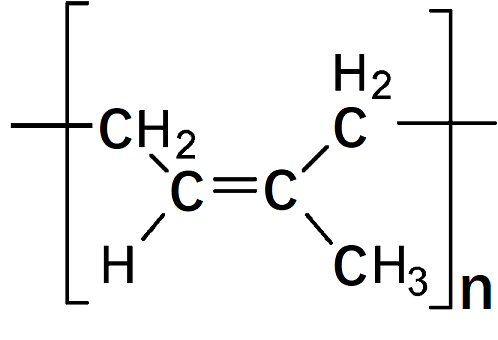POLYISOPRENE

|
- $54 - $485
- Product name: POLYISOPRENE
- CAS: 9003-31-0
- MF: C5H8
- MW: 68.12
- EINECS:618-362-9
- MDL Number:MFCD00084438
- Synonyms:2-Methylbuta-1,3-diene, ol;isoprene homopolymer;Anti-IR, C-Terminal antibody produced in rabbit;Anti-IR antibody produced in rabbit;kinase InsR;1,4-POLYISOPRENE 10'000;1,4-POLYISOPRENE 100'000;1,4-POLYISOPRENE 150'000
11 prices
Selected condition:
Brand
- scipoly
- Sigma-Aldrich
Package
- 100μG
- 500mg
- 1g
- 100ml
- Manufacturerscipoly
- Product number581
- Product descriptionPolyisoprene standard
- Packaging1g
- Price$54
- Updated2024-07-03
- Buy
- Manufacturerscipoly
- Product number1062
- Product descriptionPolyisoprene standard
- Packaging500mg
- Price$54
- Updated2024-07-03
- Buy
- Manufacturerscipoly
- Product number1063
- Product descriptionPolyisoprene standard
- Packaging500mg
- Price$54
- Updated2024-07-03
- Buy
- Manufacturerscipoly
- Product number1064
- Product descriptionPolyisoprene standard
- Packaging500mg
- Price$54
- Updated2024-07-03
- Buy
- Manufacturerscipoly
- Product number548
- Product descriptionPolyisoprene standard
- Packaging500mg
- Price$54
- Updated2024-07-03
- Buy
- Manufacturerscipoly
- Product number582
- Product descriptionPolyisoprene standard
- Packaging500mg
- Price$54
- Updated2024-07-03
- Buy
- Manufacturerscipoly
- Product number584
- Product descriptionPolyisoprene standard
- Packaging500mg
- Price$54
- Updated2024-07-03
- Buy
- Manufacturerscipoly
- Product number704
- Product descriptionPolyisoprene standard
- Packaging500mg
- Price$54
- Updated2024-07-03
- Buy
- Manufacturerscipoly
- Product number706
- Product descriptionPolyisoprene standard
- Packaging500mg
- Price$54
- Updated2024-07-03
- Buy
- ManufacturerSigma-Aldrich
- Product number651796
- Product descriptionNegative photoresist I
- Packaging100ml
- Price$170
- Updated2025-07-31
- Buy
- ManufacturerSigma-Aldrich
- Product numberSAB4501556
- Product descriptionAnti-IR antibody produced in rabbit affinity isolated antibody
- Packaging100μG
- Price$485
- Updated2023-01-07
- Buy
| Manufacturer | Product number | Product description | Packaging | Price | Updated | Buy |
|---|---|---|---|---|---|---|
| scipoly | 581 | Polyisoprene standard | 1g | $54 | 2024-07-03 | Buy |
| scipoly | 1062 | Polyisoprene standard | 500mg | $54 | 2024-07-03 | Buy |
| scipoly | 1063 | Polyisoprene standard | 500mg | $54 | 2024-07-03 | Buy |
| scipoly | 1064 | Polyisoprene standard | 500mg | $54 | 2024-07-03 | Buy |
| scipoly | 548 | Polyisoprene standard | 500mg | $54 | 2024-07-03 | Buy |
| scipoly | 582 | Polyisoprene standard | 500mg | $54 | 2024-07-03 | Buy |
| scipoly | 584 | Polyisoprene standard | 500mg | $54 | 2024-07-03 | Buy |
| scipoly | 704 | Polyisoprene standard | 500mg | $54 | 2024-07-03 | Buy |
| scipoly | 706 | Polyisoprene standard | 500mg | $54 | 2024-07-03 | Buy |
| Sigma-Aldrich | 651796 | Negative photoresist I | 100ml | $170 | 2025-07-31 | Buy |
| Sigma-Aldrich | SAB4501556 | Anti-IR antibody produced in rabbit affinity isolated antibody | 100μG | $485 | 2023-01-07 | Buy |
Properties
Melting point :64 °C
Boiling point :122-142 °C(lit.)
Density :0.92 g/mL at 25 °C
refractive index :n20/D 1.521
Flash point :>230 °F
storage temp. :2-8°C
form :slab/chunk
biological source :rabbit
λmax :310-480 nm
Cosmetics Ingredients Functions :VISCOSITY CONTROLLING
InChI :InChI=1S/C5H8/c1-4-5(2)3/h4H,1-2H2,3H3
InChIKey :RRHGJUQNOFWUDK-UHFFFAOYSA-N
SMILES :C(=C)(C)C=C
CAS DataBase Reference :9003-31-0
EPA Substance Registry System :1,3-Butadiene, 2-methyl-, homopolymer (9003-31-0)
Boiling point :122-142 °C(lit.)
Density :0.92 g/mL at 25 °C
refractive index :n
Flash point :>230 °F
storage temp. :2-8°C
form :slab/chunk
biological source :rabbit
λmax :310-480 nm
Cosmetics Ingredients Functions :VISCOSITY CONTROLLING
InChI :InChI=1S/C5H8/c1-4-5(2)3/h4H,1-2H2,3H3
InChIKey :RRHGJUQNOFWUDK-UHFFFAOYSA-N
SMILES :C(=C)(C)C=C
CAS DataBase Reference :9003-31-0
EPA Substance Registry System :1,3-Butadiene, 2-methyl-, homopolymer (9003-31-0)
Safety Information
| Symbol(GHS): |
  
|
||||||||||||||||||||||||||||||||||||||||||
|---|---|---|---|---|---|---|---|---|---|---|---|---|---|---|---|---|---|---|---|---|---|---|---|---|---|---|---|---|---|---|---|---|---|---|---|---|---|---|---|---|---|---|---|
| Signal word: | Danger | ||||||||||||||||||||||||||||||||||||||||||
| Hazard statements: |
|
||||||||||||||||||||||||||||||||||||||||||
| Precautionary statements: |
|
Description
Polyisoprene is the polymer known as natural rubber, although it can also be manufactured. The natural rubber latex is harvested from the rubber tree, Hevea brasiliensis. This substance has a variety of natural additives, such as proteins and sugars. The polymer from the natural latex is resistant to many solvents and also is easily processed. The synthetic form of this rubber is produced from a pure isoprene solution with a stereospecific isomer to produce the more commonly used cis-l,4 isomer. These rubbers are resistant to abrasion and most solvents and are commercially used in automobile tires, adhesives, and a variety of products that come in close contact with the general public. Their use in baby bottle nipples is a good indication of the extremely low toxicity associated with these elastomers.
Related product price
- 104389-31-3
$25-196 - POLYISOPRENE TRANS
$30-256 - Isotretinoin
$10-1767.15
Suppliers and manufacturers
Henan Tianfu Chemical Co.,Ltd.
ANHUI WITOP BIOTECH CO., LTD
Henan Alfa Chemical Co., Ltd
Alfa Chemistry






